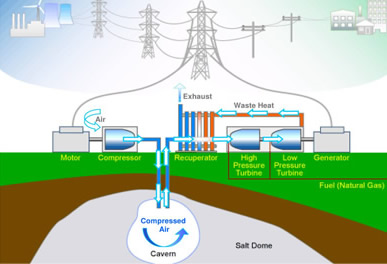Compressed Air Energy Storage FAQ
We have been learning so much reading all about compressed air energy storage online at Energystorage.org. We sampled some of our favorite questions and answers from their FAQ page.
Read more online at http://energystorage.org/energy-storage/faq.
Why do we need energy storage?
The primary benefits are:
Risk of Power Outages: Today’s electricity grid is increasingly vulnerable to threats from nature, terrorists, and accidents. Millions of American families and businesses are victimized by outages (both sustained and monentary) each year. Power outages cost as much as $130 billion annually, while hitting the job-creating commercial and industrial sectors the hardest.
Saving Consumers Money: Sixty million Americans in thirteen states plus Washington, DC are saving money because energy storage systems are providing frequency regulation in PJM territory (the power transmission operator in the mid-Atlantic region). PJM has projected that a 10-20% reduction in its frequency regulation capacity procurement could result in $25 million to $50 million savings to consumers. Energy storage can also let customers avoid premium pricing that utilities charge during times of peak demand. That’s like getting a cheap airline flight on Thanksgiving or a rush-hour subway pass at an off-peakprice.
Clean Energy Integration and Energy Independence: Energy storage supports the integration of renewable energy generation. Energy storage can also help cut emissions as it takes more of the load off fossil-fuel generation. Peaking generation is one of the most costly and wasteful aspects of the grid, so making existing generation go further and avoiding capital and resource-intensive new facilities would make a significant contribution to our environmental priorities. By supporting an all-of-the-above energy strategy, storage will also help accelerate our drive to energy independence.
Economy and Jobs: In addition to reducing economic losses from major and minor annual outages, experts say that energy storage will be a critical technology in the electricity grids of the future. They also predict that the long term-health of the U.S. economy, and tens of thousands of future U.S. jobs, depend in no small part on the ability of U.S. companies to at least remain competitive, if not to become leaders, in this critical technology.

Compressors use off-peak electricity to fill the cavern with compressed air. For peak demand, the compressed air is withdrawn from the cavern and used to power a wind turbine. Credit: Ridge Energy Storage & Grid Services LP
Read more at: http://phys.org/news/2010-03-compressed-air-energy-storage-renewable.html#jCp
Is energy storage clean?
Yes. Energy storage has no direct emissions. It requires no pipelines. Its systems typically require a minimal footprint. It recycles electricity. But energy storage will also help cut emissions as it takes more of the load off traditional generation.
How big is the energy storage market?
Energy storage systems currently make up approximately 2% of U.S. generation capacity. That percentage is growing significantly, especially with the advent of more renewable energy. Pumped hydroelectric power has played an important part of our electricity grid since the 1930s. Yet today, electricity from wind, solar and other ‘intermittant’ sources have created urgent needs for additional energy storage.
World-wide demand for grid-scale energy storage is estimated to reach over 185.4 gigawatt-hours (GWh) by 2017 – which is approximately the amount of electricity New York City consumes in 17 days. That represents a $113.5 billion incremental revenue opportunity for an industry that currently generates sales of $50-60 billion a year.
